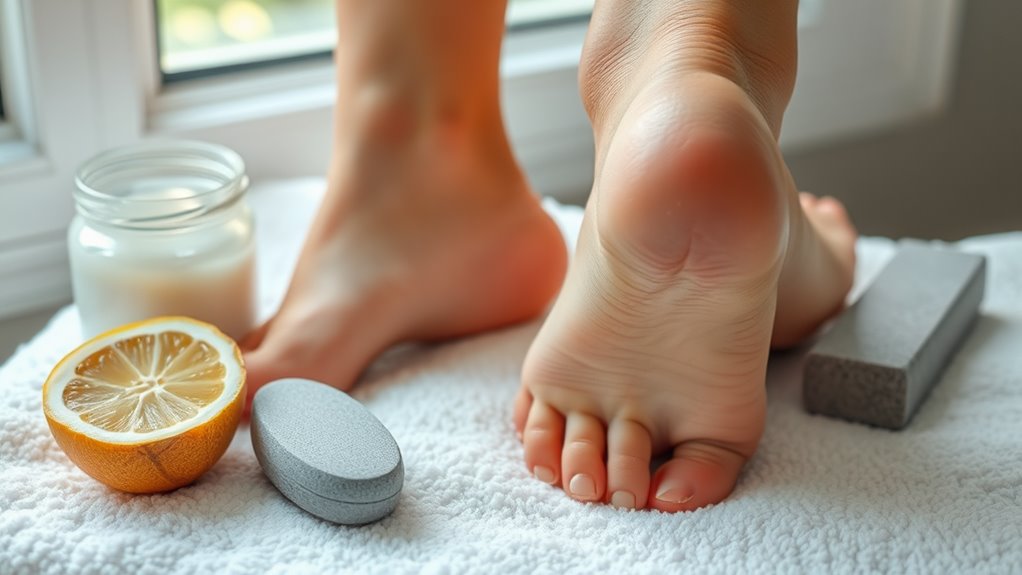These Cracked Heel Hacks Had My Feet Smooth Again
You’ll need to target the hyperkeratotic stratum corneum to heal those cracked heels effectively. Start with mechanical debridement using a pumice stone, then apply 40% urea-based moisturizer nightly with occlusive socks. Incorporate natural remedies like coconut oil’s medium-chain fatty acids or honey-lemon soaks at 40°C for keratin breakdown. For persistent fissures, alternate glycolic and hyaluronic acids. The science behind heel fissure treatment reveals even more powerful solutions.
Understanding What Causes Cracked Heels
Why do seemingly healthy feet develop painful fissures in the heel area?
The primary cause is hyperkeratosis, where your stratum corneum thickens due to mechanical stress.
When this thickened skin lacks moisture, it becomes rigid and cracks under pressure. It’s important to note that conditions like diabetes-related issues can exacerbate heel fissures and require medical attention. Before attempting heel repair DIY methods, understand that underlying conditions like diabetes, obesity, or plantar pressure abnormalities can exacerbate heel fissures and require medical attention.
Essential Items for Home Heel Treatment
Several fundamental items are essential for an effective home-based heel fissure treatment protocol.
You’ll need a pumice stone or foot file for mechanical debridement, urea-based moisturizers (40% concentration), antimicrobial ointment, sterile gauze, medical tape, and occlusive socks.
A foot soaking basin and epsom salts facilitate hyperkeratotic tissue removal.
Keep antibiotic cream available for deep fissures. Regular exfoliation techniques can also enhance the effectiveness of your treatment routine.
Overnight Moisturizing Methods That Work
Nighttime treatment offers ideal conditions for deep moisturization of cracked heels, as the skin’s regenerative processes peak during sleep. Apply urea-based moisturizer liberally to affected plantar surfaces, then cover with occlusive cotton socks. For enhanced penetration, exfoliate stratum corneum first. Alternate between glycolic acid and hyaluronic acid treatments to optimize epidermal barrier repair while maintaining dermal hydration. Consistent use of an overnight balm can significantly improve skin texture and promote healing.
Natural Remedies From Your Kitchen
Your kitchen contains potent natural remedies that can effectively treat plantar epidermal fissures and hyperkeratosis of the heel.
Begin with coconut oil’s medium-chain fatty acids to penetrate and soften callused tissue, followed by a banana’s enzymatic properties and potassium content to promote cellular repair.
A honey-lemon foot soak combines the antimicrobial action of honey with citric acid’s natural exfoliating properties to reduce bacterial colonization while smoothing damaged skin. Additionally, incorporating daily moisturizing practices can help maintain foot health and prevent future issues.
Coconut Oil Softens Heels
Coconut oil’s rich medium-chain fatty acids penetrate deep into the stratum corneum of cracked heel tissue, promoting epidermal repair and moisture retention. You’ll find this natural lipid particularly effective when applied to warm, exfoliated plantar surfaces. Your stratum corneum absorbs it efficiently through transepidermal pathways.
| Time | Application Method | Tissue Response |
|---|---|---|
| Morning | Gentle Massage | Lipid Barrier Formation |
| Afternoon | Occlusive Wrap | Ceramide Production |
| Evening | Deep Infiltration | Keratinocyte Repair |
| Night | Bandage Cover | Collagen Synthesis |
Banana Mask Treatment
A potent banana mask formulation leverages the fruit’s proteolytic enzymes and potassium content to facilitate stratum corneum desquamation while promoting epidermal cell turnover.
To apply, mash one ripe banana until it forms a homogeneous paste.
Apply directly to the hyperkeratotic plantar surface, focusing on fissured areas.
Wrap with occlusive dressing for 20 minutes.
The enzymatic action will soften the stratum corneum, enabling efficient debridement.
Honey-Lemon Foot Soak
This therapeutic foot soak combines antimicrobial manuka honey with citrus-derived alpha hydroxy acids to create an effective keratolytic solution. You’ll want to immerse your plantar epidermis for precisely 15 minutes while the acidic compounds break down hyperkeratotic tissue.
| Time (min) | pH Level | Tissue Response |
|---|---|---|
| 0-5 | 4.5 | Initial Softening |
| 5-10 | 4.2 | Keratin Breakdown |
| 10-15 | 4.0 | Deep Penetration |
| 15-20 | 3.8 | Maximum Efficacy |
| 20+ | 3.5 | Risk of Irritation |
For best results, maintain water temperature at 40°C (104°F) throughout the treatment.
Weekly Foot Care Routine for Prevention
Regularly maintaining healthy foot integument requires a structured weekly regimen to prevent plantar epidermis fissures and hyperkeratosis.
You’ll need to exfoliate stratum corneum accumulation bi-weekly using a pumice implement.
Apply emollient-rich moisturizer post-bathing to maintain epidermal hydration.
Utilize occlusive barriers nightly, focusing on calcaneal regions.
Don medical-grade silicone heel socks during nocturnal rest periods for effective dermal repair. Additionally, proper foot care routines enhance comfort and boost confidence.
When to Seek Professional Help
Despite diligent home care protocols, certain plantar integument conditions necessitate professional podiatric intervention.
You’ll need immediate podiatric consultation for:
- Deep fissures extending beyond the epidermis with signs of infection (erythema, purulence)
- Concurrent manifestations of diabetes mellitus with peripheral neuropathy
- Persistent hyperkeratotic lesions resistant to conservative therapeutic interventions after two weeks
These conditions require specialized debridement and targeted antimicrobial therapy.
